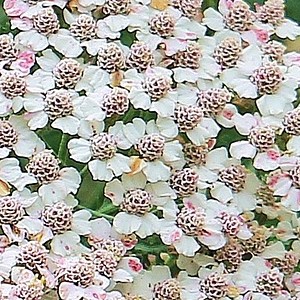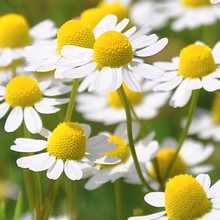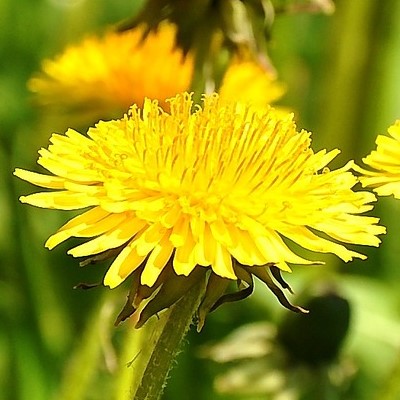The Compost Preparations and the Individuality of the Farm Organism
Peter Stewart, August 2017
Working with the compost preparations, whether placing them within a freshly built compost heap, or participating in their making, is an essential part of biodynamics, and yet they remain deeply mysterious. There are few people today who could claim to fully comprehend them. Biodynamic researchers and practitioners since Rudolf Steiner, like Bernard Lievegoed (i), Maria Thun and others, have attempted to come to an understanding of the compost preparations by, for example, showing how each preparation is related to the working of a specific planetary action within the life-processes or how each provides for an organ-like function within the organisation of the compost heap, but as these connections are not actually made in the Agriculture Course, it is interesting to look at the admittedly brief indications which Steiner gave.
 Before progressing to the compost preparations, it is necessary to look at the implications of considering the farm as an organism, in the Anthropsophical sense. In the second lecture of the Agriculture Course, Rudolf Steiner first presents the picture that the farm can be considered to be an organism with its head in the ground and belly above ground, with the layer of living soil acting like a diaphragm between the upper pole and the lower pole. It is a threefold being, with its nerve-sense head system in the ground, its metabolic system working in all that is above ground, and the living soil, like the heart-lung system, mediating between the two. These should not be seen as three static elements layered one on top of the other, but as two polar tendencies, the head and the belly, which stream into and through each other, mediated by the middle realm. This image of the farm organism is directly connected to the image of the human being presented in the medical lectures, where the health of the organism arises through the balanced interaction between the formative tendencies of upper pole of the human being, and the lower pole of the human being, with the heart mediating between the two.
Before progressing to the compost preparations, it is necessary to look at the implications of considering the farm as an organism, in the Anthropsophical sense. In the second lecture of the Agriculture Course, Rudolf Steiner first presents the picture that the farm can be considered to be an organism with its head in the ground and belly above ground, with the layer of living soil acting like a diaphragm between the upper pole and the lower pole. It is a threefold being, with its nerve-sense head system in the ground, its metabolic system working in all that is above ground, and the living soil, like the heart-lung system, mediating between the two. These should not be seen as three static elements layered one on top of the other, but as two polar tendencies, the head and the belly, which stream into and through each other, mediated by the middle realm. This image of the farm organism is directly connected to the image of the human being presented in the medical lectures, where the health of the organism arises through the balanced interaction between the formative tendencies of upper pole of the human being, and the lower pole of the human being, with the heart mediating between the two.
In Anthroposophy the human being is also membered into several interrelated bodies or layers of being, the physical body, the etheric body or body of life forces, and the astral or soul body, which provide sheaths for the incarnating spiritual I or ego. The physical body provides our earthly ground, the etheric body brings living form and life which unfolds in time, the astral body brings movement, both inward and outward, and sentience, and all of this is impressed with wholeness through the I. This fourfold structuring of the human being is a reflection on a small scale of the general structure of the cosmos. The cosmos has a physical level, an elemental world, a soul world and spiritual levels of existence. The levels of our being relate to and originate from these levels in the cosmos. These levels of being are archetypal because they not only reflect the structuring of the cosmos, but are also reflected in the structuring of the various beings within the cosmos, like plants, animals and minerals, thus the lawfulness of the whole is reflected into every part.
The human being on earth embodies and individualises these levels of being into the various bodies. As an organism, the plant on earth has only a physical and etheric body, it has form and life, but it does not individualise and incarnate the astral and spiritual ego principles into a physical body as the human being does, though it does have these levels of being, which hover above the physical-etheric organism, so to speak. When we speak about the individuality of the farm organism it is safe to assume that these levels of being are present also. In lecture two of the Agriculture Course, we can find that Steiner makes the statement that the earthly soil is not just mineral earth but also contains degree of life and astrality. Though the farm organism can be thought of in terms of a self-sufficient and closed system of circulating nutrients, this type of mental picture, especially if our idea of chemical substances is too material and not directed to their activity as forces, does not go far enough towards the idea of the farm organism as a real being, with the archetypal levels of being.
To help with our picturing of the interaction of these levels of being, the following quotation from Rudolf Steiner gives a brief picture of the dynamic interplay between the physical and etheric bodies:
“What would happen if the etheric body were to leave the physical body, even for a moment? The physical body would contract, shrivel and become wrinkled; it has the tendency to contract into the smallest space possible and ultimately dissolve into nothing. The tendency of the etheric body is to expand into the widths of space; it feels itself connected with all the forces out in space. It fills the physical body and spreads it out to the size it has. (23 August 1911)
It is the astral body which works into these two polar tendencies stimulating development, transformation and metamorphosis, as left to itself the etheric body would only reproduce more of the same. As the highest spiritual principle, the I imprints all of this into a whole, a unity. From the point of view of anthroposophical medicine, the higher principle always works upon the lower, thus we have a functional order of:
Ego
Astral body
Etheric body
Physical body
In the medical lectures Steiner draws the picture that the real source of illness in the human being does not initially lie in any external cause, like bacteria, but is fundamentally due to an the irregular working in the balance between the different bodies, where for example the life forces of the etheric body may work too strongly or too weakly, or in some conditions the astral body may be too weak to be able to regulate the etheric body, or in others, works too strongly into the physical body, causing pain. It is the underlying imbalance between the bodies, which provides the ground for illness, infections and the like. Healing results from the restoration of balance.
We can find this same picture of the regulation of the balanced interaction of the various levels of being of an organism in Steiner’s indications for the compost preparations, which provide support for a healthy building up of the individualised farm organism.
Thus, in connection with the yarrow preparation, though he does make other indications about the preparation in relation to sulphur and potassium, in this context, it is interesting to see that Steiner charactierises the working of yarrow by saying “it can make good all that is due to weaknesses of the astral body”. This is a first imbalance between the various bodies which he mentions, when the astrality works too weakly.
 When describing the Chamomile preparation he says it works “to exclude from the plant those harmful effects of fructification”. To understand what is meant by fructification, we only need recall that in lecture three of the Agriculture Course, Steiner characterises the nitrogen building activity of the pea family as a tendency “to fruit even before they come to flower” and points out that this is because they draw the nitrogen element, the bearer of cosmic astrality, too close to the earth, and for these plants, down into the leafy realm. Thus, the transition from merely vegetative growth to fructification is a working of the astral on the plant, so we can say that the harmful effects of fructification arises from a too strong working of the astral.
When describing the Chamomile preparation he says it works “to exclude from the plant those harmful effects of fructification”. To understand what is meant by fructification, we only need recall that in lecture three of the Agriculture Course, Steiner characterises the nitrogen building activity of the pea family as a tendency “to fruit even before they come to flower” and points out that this is because they draw the nitrogen element, the bearer of cosmic astrality, too close to the earth, and for these plants, down into the leafy realm. Thus, the transition from merely vegetative growth to fructification is a working of the astral on the plant, so we can say that the harmful effects of fructification arises from a too strong working of the astral.
Of the oak bark preparation, Steiner quite explicitly says “it restores order when the etheric body is working too strongly, that is, when the astral cannot gain access to the organic entity. It “kills” or damps down the etheric body, and thereby makes free the influences of the astral body…But if we want a rampant etheric development, of whatsoever kind, to withdraw in a regular manner – so that its shrinking is beautiful and regular and does not give rise to shocks in the organic life – then we must use the calcium in the very structure in which we find it in the bark of the oak.” So oak bark works where the working of the etheric, the growth forces, is too strong.
When describing the nettle preparation, Steiner connects the nettle to the action of our heart and blood, which is the bearer of the individualising ego-forces in our own organism. This preparation will “make the earth itself intelligent – the earth into which the manure is worked. The soil will individualise itself , the permeation of the soil with reason and intelligence.” Thus we have a preparation which supports the individuality of the farm organism to bring an overarching order into the whole, through the middle rhythmic system of the layer of the living soil.
Looking at the compost preparations in this way, we have:
Nettle – supports the working of the individuality of the farm organism
Chamomile – restores balance when the astral works too strongly
Yarrow – strengthens the working of weak astrality
Oak bark – restores balance when the etheric body works too strongly
From the standpoint of the medical lectures, we would say that these four preparations work to harmonise and heal the imbalances and irregular workings between the levels of being of the farm organism.
In relation to the remaining two compost preparations we can continue to build up the picture of the individuality of the farm organism.
 When describing the dandelion preparation, Steiner indicates that due to the dandelion’s relationship to silica, which as a process streams outward in self-transparent selflessness, it provides the farm organism with senses or sensitivity, so that, we could say, as an individuality it can open up and ‘look beyond itself’, to be open to all that surrounds it, “it will grow sensitive to all things, and will draw to itself all that it needs”.
When describing the dandelion preparation, Steiner indicates that due to the dandelion’s relationship to silica, which as a process streams outward in self-transparent selflessness, it provides the farm organism with senses or sensitivity, so that, we could say, as an individuality it can open up and ‘look beyond itself’, to be open to all that surrounds it, “it will grow sensitive to all things, and will draw to itself all that it needs”.
The valerian preparation is only briefly mentioned, all Rudolf Steiner says is that it “stimulates it to behave in the right way in relation to what we call the ‘phosphoric’ substance”. With the phrase “phosphoric substance”, he is using an alchemic term to characterise substances which bear the imponderable etheric forces, like light and warmth, within themselves, in contrast to the polar salt-like substances, which are the bearers of ponderable earthly forces[i]. Phosphorus is the bearer of etheric light. In Lecture 3 of the Curative Education course Steiner clarifies that the etheric “light” which Spiritual Science refers to is the light that lives in in all our sense perceptions{iii]. Continuing the picture, we can say that once the organism has received “senses”, an open sensitivity, through the working of silica in the dandelion preparation, it is to the phosphoric forces of light that those senses open. On the “phosphoric substances” as healing remedies in the human organism, he says in the medical lectures that they are “especially conducive to bringing the astral body and the ego into closer relationship with the physical organism”, to allow the more spiritual principles to find their expression in the more material.
Notes
(i)See for example, Bernard Lievegoed, The Working of the Planets and the Life Processes in Man and Earth, 1950.
(ii)See R.Steiner, Lecture 5, Spiritual Science and Medicine, Rudolf Steiner Press, London, 1948:
“All the forces inherent in phosphorus, e.g., are polar opposites to those in carbonate of lime. (The expressions I use in this connection are at least no less scientific, in their true significance, than much that today passes for science.) If all “saline substances” behave in such a way as to give themselves up to the environment, the reason is that all salts arise through deprivation and liberation of the corresponding substances from the inner workings of light and other imponderable elements. I might say that all that is saline has so repelled the imponderable elements through its very origin that they are alien to it.
Of phosphorus the exact contrary is true. Ancient atavistic knowledge was indeed not without justification in calling phosphorus the Light-bearer. Men saw that phosphorus does carry and contain that imponderable light. What salt repels and holds at bay, phosphorus carries within it. Thus the substances at the opposite pole from salt, are those that appropriate, so to speak, the imponderable entities — principally light, but also others, for instance, warmth — and interiorise them, making them their inner properties. This is the basis of the remedial efficacy of all the qualities of phosphorus, and of all that is allied to phosphorus in its healing effect. Therefore phosphorus, in which the imponderable are internally stored, is especially conducive to bringing the astral body and the ego into closer relationship with the physical organism.”
(iii) See R. Steiner, Lecture 3, Curative Education, Rudolf Stiner Press, 1972:
“You look out upon the world around you, and perceive it all lit up. What enables you to do this? Something gives you the capacity to perceive the world illumined in this way, and it is something in the ether. Light is, in fact, an ether force. Modern science speaks of light as of something that is present where we see things illumined. Spiritual Science speaks of light in another way. It calls “light” that which underlies other sense-perceptions too; it speaks, for example, of the light of perceptions of sound. Present-day physics, when it speaks of perceptions of sound, is in reality speaking merely of their external correlate — namely, the vibration of the air. The movements in the air are but the medium of the real sound or tone, which is something etheric; the vibrating that goes on in the etheric brings about the vibration of the air. Light lives also in the perceptions of smell. In short, all perceptions have as their basis a light of a kind that is much more all-pervading than the light that is spoken of in the physics of the present day.”